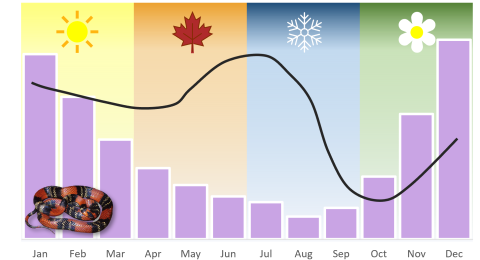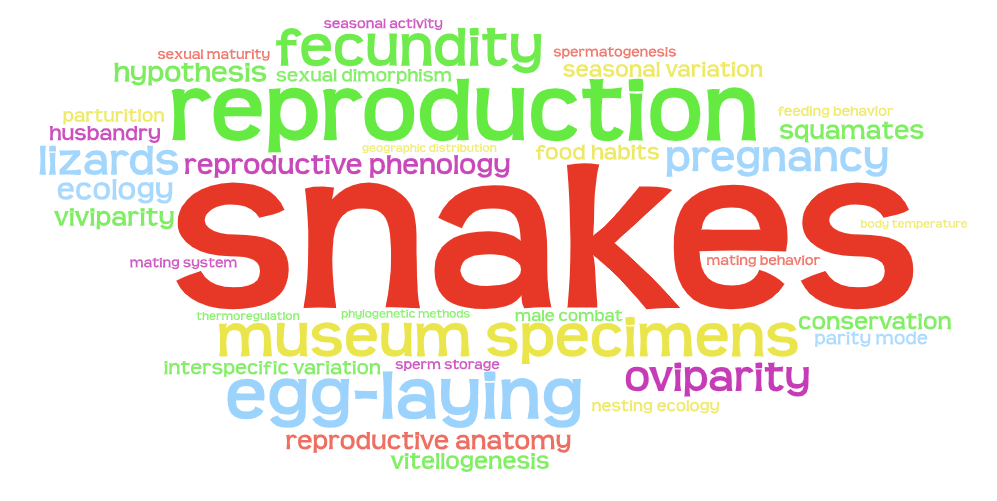Henrique Braz
Herpetology • Natural History • Evolution • Scientific Editing
Research
Reproductive Biology • Natural History • Evolution

Evolution of Reproductive Modes
How and why multiple lizards and snakes have changed the way they produce their babies?
Viviparity (live birth) has evolved an extraordinary number of times (>150) independently among vertebrates. The origin of viviparity imposes several physiological challenges that need to be overcome (elimination of metabolic waste, exchange of respiratory gases, and transport of water and nutrients). Moreover, viviparity dramatically changes the way an organism interacts with its environment.
I have studied the evolution of viviparity in squamates (snakes and lizards), the group that, by far, exhibits most (~75%) origins of viviparity. Specifically, I focus on morphological, ecological, and phylogenetic aspects of the transition to viviparity. I aim to understand how and why multiple species have achieved this evolutionary transition.
Related publications
- Uterine and eggshell modifications associated with the evolution of viviparity in South American water snakes
Braz HB, Almeida-Santos SM, Murphy CR, Thompson MB.
J Exp Zool B: Mol Dev Evol 330(3): 165-180. 2018.
Reproductive modes of the South American water snakes: A study system for the evolution of viviparity in squamate reptiles
Braz HB, Scartozzoni RR, Almeida-Santos SM.
Zoologischer Anzeiger 263: 33–44. 2016.
In the media
Interview with National Geographic: This frog’s babies erupt out of its back—and other surprising ways animals give birth
Interview about my work with the eUpdate (Newsletter of the School of Biological Sciences of The University of Sydney) (2015).
Collaborators
Dr. Selma Almeida-Santos, Instituto Butantan, Brazil
Prof. Mike Thompson, University of Sydney, Australia
Prof. Chris Murphy, University of Sydney, Australia
Gallery

Evolution of Reproductive Phenology & Life History
How are animal reproductive patterns shaped by the environment and evolutionary history?
Brazil has more than 730 species of squamates (lizards, snakes, and amphisbaenians), but the reproductive phenology and life-history traits of most of these species remain poorly known.
One of my research interests is thus to characterize reproductive output parameters (e.g., clutch size, reproductive frequency) and the timing of reproductive events (e.g., gametogenesis, mating, sperm storage, ovulation, and egg-laying/parturition) of squamate reptiles in Brazil.
My overarching goal is to understand how squamate reproductive patterns are shaped by their environment and evolutionary history.
Related publications
Reproductive ecology of the Amaral’s blind snake Trilepida koppesi in an area of Cerrado in south-eastern Brazil
Khouri RS, Fiorillo BF, Braz HB, Maciel JH, Almeida-Santos SM, Martins M.
Herpetological Journal 32: 70-79. 2022.
Reproduction in the pitviper Bothrops jararacussu: Large females increase their reproductive output while small males increase their potential to mate
Silva KMP, Braz HB, Kasperoviczus KN, Marques OAV, Almeida-Santos SM.
Zoology 142: 125816. 2020.
Reproductive biology of the fossorial snake Apostolepis gaboi: a threatened and poorly known species from the Caatinga region
Braz HB, Kasperoviczus KN, Guedes TB.
South American Journal of Herpetology 14(1): 37-47. 2019
Reproductive ecology and diet of the fossorial snake Phalotris lativittatus in the Brazilian Cerrado
Braz HB, Kasperoviczus KN, Almeida-Santos SM.
Herpetological Journal 24(1): 49-57. 2014.
In the media
Interview with ((o))eco: Study on tropical snakes reveals high diversity in the Cerrado (in Portuguese)
Collaborators
Dr. Selma Almeida-Santos, Instituto Butantan, Brazil
Dr. Otavio Marques, Instituto Butantan, Brazil
Dr. Thais Guedes, State University of Campinas, Brazil
Gallery

Natural History
How do snakes and lizards live in their natural environment?
As with reproductive biology, many other aspects of the natural history of Brazilian snakes and lizards are still poorly known. Accordingly, I have also always been interested in investigating various aspects of the natural history of squamate reptiles.
Some of the natural history studies I have conducted address feeding ecology, feeding behavior, activity patterns, and geographic distribution.
Related publications
Atlas of Brazilian snakes: verified point-locality maps to mitigate the Wallacean shortfall in a megadiverse snake fauna
Nogueira CC, Argôlo AJS, Arzamendia V, Azevedo JA, Barbo FE, Bérnils RS, Bolochio BE, Borges-Martins M, Brasil-Godinho M, Braz HB, Buononato M, Cisneros-Heredia DF, Colli GR, Costa HC, Franco FL, Giraudo A, Gonzalez RC, Guedes TB, Hoogmoed MS, Marques OAV, Montingelli GG, Passos P, Prudente ALC, Rivas GA, Sanchez PM, Serrano FC, Silva-Jr NJ, Strüssman C, Vieira-Alencar JPS, Zaher H, Sawaya RJ, Martins M.
South American Journal of Herpetology 14(special issue 1): 1-274. 2019.
Distribution of the Neotropical water snakes Hydrops caesurus, H. martii, and H. triangularis in South America, with new records from Peru and Brazil
von May R, Albuquerque NR, Braz HB, Santa-Cruz R, Biggi E, Tomasinelli F, Rabosky DL.
Amphibian & Reptile Conservation 13(1): 122-142. 2018.
Patterns, biases and prospects in the distribution and diversity of Neotropical snakes
Guedes TB, Sawaya RJ, Zizka A, Laffan S, Faurby S, Pyron RA, Bérnils RS, Jansen M, Passos P, Prudente ALC, Cisneros-Heredia DF, Braz HB, Nogueira CC, Antonelli A.
Global Ecology and Biogeography 27(1): 14-21. 2018.
Tail-first ingestion of prey by the false coral snake, Erythrolamprus aesculapii: Does it know where the tail is?
Braz HB, Marques OAV.
Salamandra 52(2): 211–214. 2016.
In the media
Interview with ((o))eco: Study on tropical snakes reveals high diversity in the Cerrado (in Portuguese)
Collaborators
Dr. Otavio Marques, Instituto Butantan, Brazil
Dr. Thais Guedes, State University of Campinas, Brazil
Gallery


